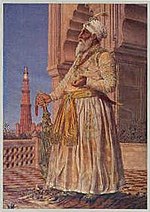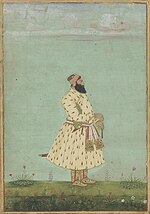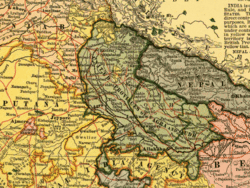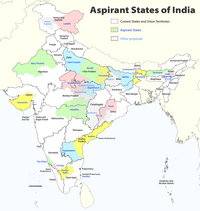Awadh
This articleneeds additional citations forverification.(May 2024) |
Awadh | |
|---|---|
 Modern map of the Awadh region | |
| Coordinates:26°53′N80°58′E/ 26.883°N 80.967°E | |
| Continent | Asia |
| Country | India |
| State | Uttar Pradesh |
| Covering territory | |
| Languages | Awadhi,HindiandUrdu |
| Area | |
| • Total | 68,006 km2(26,257 sq mi) |
| Population (2011) | |
| • Total | 55,119,236[citation needed] |
| Largest Cities | |

Awadh(Hindi:[əˈʋədʱ]), known in British historical texts asAvadhorOudh,is ahistorical regionin northern India, now constituting the northeastern portion ofUttar Pradesh.It is roughly synonymous with the ancientKosalaregion ofHindu,Buddhist,andJain scriptures.[2]
It was a province of all the majorIslamic dynasties in Indiaincluding theMughal Empire.With the decline of late MughalDelhi,Awadh became a major source of literary, artistic, religious, and architectural patronage in northern India under the rule of its eleven rulers, calledNawabs.From 1720 to 1856, the nawabs presided over Awadh, withAyodhyaandFaizabadserving as the region's initial capitals.[3]Later, the capital was relocated toLucknow,which is now the capital ofUttar Pradesh.[4]
The British conquered Awadh in 1856, which infuriated Indians and was recognised as a factor causingIndian Mutiny (1857-58),the biggest Indian uprising against British rule.[5]
Etymology
[edit]The wordAwadhis inherited from theSanskritwordAyodhyameaning "not to be warred against, irresistible".[6][7][8]
History
[edit]Awadh, known as the granary of India, was important strategically for the control of theDoab,a fertile plain between theGangesand theYamunarivers. It was a wealthy kingdom, able to maintain its independence against threats from theMarathas,theBritishand theAfghans.
Ancient
[edit]Awadh's political unity can be traced back to the ancientHindukingdom ofKosala,withAyodhyaas its early capital in traditional history, though in Buddhist times (6th–5th centuryBCE)Shravastibecame the kingdom's capital city.[9]
Modern Awadh finds historical mention only in the Mughal time ofAkbar,in the late 16th century.
In prehistoric times, Awadh, reputedly the kingdom of Bikukshi, contained five main divisions:[10]
- Uttara Kosalaor the trans-Ghaghradistricts, now known asBahraich,Gonda,BastiandGorakhpur.
- Silliana,consisting of lower range of hills to the north of Uttara Kosala, now belonging toNepal,with theTaraiat its base.
- Pachhimrath,which may be roughly described as the country between Ghaghra andGomtiwest to the line fromAyodhyatoSultanpur.This division included about third of present district of Ayodhya (includingAmbedkar Nagar), a small portion of the north ofSultanpur,greater part ofBarabanki,and sections of the Lucknow andSitapurdistricts.
- Purabrath,which may be roughly described as the country between Ghaghra and Gomti east to the line from Ayodhya to Sultanpur. This division included about two-thirds of present district of Ayodhya (includingAmbedkarnagar), the north-eastern corner of Sultanpur, and parts ofMirzapur district,Pratapgarh DistrictandJaunpur.
- Arbar,extended southwards from Gomti to theSai river.
Before independence
[edit]Since AD 1350 different parts of the Awadh region were ruled by theDelhi Sultanate,Sharqi Sultanate,Mughal Empire,Nawabs of Awadh,East India Companyand theBritish Raj.Kanpurwas one of the major centres ofIndian rebellion of 1857,participated actively inIndia's Independence movement,and emerged as an important city ofNorth India.
For about eighty-four years (from 1394 to 1478), Awadh was part of theSharqi SultanateofJaunpur;emperorHumayunmade it a part of the Mughal Empire around 1555. EmperorJehangirgranted an estate in Awadh to a nobleman, Sheik Abdul Rahim, who had won his favour. Sheik Abdul Rahim later built Machchi Bhawan in this estate; this later became the seat of power from where his descendants, the Sheikhzades, controlled the region. Until 1719, theSubahof Awadh (bordering (Old) Delhi, Agra, Illahabad and Bihar) was a province of theMughal Empire,administered by a Nazim or Subah Nawab (governor) appointed by the Emperor. Nawab –the plural of theArabicword 'Naib', meaning 'assistant'– was the term given tosubahdars(provincial governors) appointed by the Mughal emperor all over India to assist him in managing the empire. In the absence of expeditious transport and communication facilities, they were practically independent rulers of their territory and wielded the power of life and death over their subjects. Persian adventurerSaadat Khan,also called Burhan-ul-Mulk, was appointed the Nazim of Awadh in 1722 and he established his court inFaizabad[11]nearLucknow.TheNawabs of Lucknowwere in fact the Nawabs of Awadh, but were so referred to because after the reign of the third Nawab, Lucknow became the capital of their realm, where the British stationResidents('diplomatic' colonial Agents) from 1773. The city was "North India's cultural capital"; its nawabs, best remembered for their refined and extravagant lifestyles, were patrons of the arts. Under them music and dance flourished, and many monuments were erected.[12]Of the monuments standing today, theBara Imambara,theChhota Imambaraand theRumi Darwazaare notable examples. One of the more lasting contributions by the Nawabs is thesyncreticcomposite culture that has come to be known as theGanga-Jamuni Tehzeeb.
Awadh under the Mughals
[edit]From the pre-historic period to the time ofAkbar,the limits of thesubah(imperial top-level province) and its internal divisions seem to have been constantly changing, and the name of Oudh, or Awadh, seems to have been applicable to only one of the ancient divisions orSarkars,nearly corresponding to oldPachhimrath.The title of Subehdar (governor) of Awadh is mentioned as early as 1280 AD, but it can only have denoted the governor of the tract of the country above defined. The Awadh of Mughal Badshah (emperor)Akbarwas one of the twelve (or fifteen)subahsinto which he divided the Mughal Empire as it stood in 1590. As constituted at the end of the sixteenth century, theSubahcontained fivesarkars,viz. Awadh, Lucknow,Bahraich,KhairabadandGorakhpur,which in turn were divided in numerousmahalsanddasturs(districts).
Khan Zaman Khan Ali Asgharson ofQazi Ghulam Mustafawas appointed asSubahdarof Awadh during the reign ofFarrukhsiyar.This appointment was made in place of 'Aziz Khan Chughtai'.[13]Later on, Mahabat Khan was appointed asSubahdarof Awadh in place of Khan Zaman Khan Ali Asghar, who was all over again transferred toAzimabad(Patna) asSubahdarin place of 'Sar Buland Khan'.[14]

It seems to have been of nearly the same extent as theProvince of Oudhat the time of annexation toBritish Indiain 1858, and to have differed only in including Gorakhpur,Basti,andAzamgarh,and in excluding Tanda, Aldemau,Rajesultanpurand Manikpur, or the territory to the east and South of Faizabad,SultanpurandPratapgarh.[15]
Under the hereditary Nawabs of Awadh
[edit]




As theMughalpower declined and the emperors lost their paramountcy and they became first the puppets and then the prisoners of their feudatories, so Awadh grew stronger and more independent. Its capital city was Faizabad.Saadat Khan,the firstNawabof Awadh, laid the foundation of Faizabad at the outskirt of ancient city ofAyodhya.Faizabad developed as a township during the reign of Safdar Jang, the second nawab of Avadh (1739–54), who made it his military headquarters while his successorShuja-ud-daulamade it a full-fledged capital city. Shuja-ud-Daula, the third Nawab of Awadh, built a fort known as "Chhota Calcutta", now in ruins. In 1765 he built the Chowk and Tir-paulia and subsequently laid out the Angoori Bagh and Motibagh to the south of it, Asafbagh and Bulandbagh to the west of the city. During the reign of Shuja-Ud-Daula, Faizabad attained such a prosperity which it never saw again. The Nawabs graced Faizabad with several notable buildings, including theGulab Bari,Moti Mahal and thetomb of Bahu Begum.Gulab Baristands in a garden surrounded by a wall, approachable through two large gateways. These buildings are particularly interesting[citation needed]for their assimilative architectural styles. Shuja-ud-daula's wife was the well known Bahu Begum, who married the Nawab in 1743 and continued to reside in Faizabad, her residence being the Moti-Mahal. Close by at Jawaharbagh lies her Maqbara, where she was buried after her death in 1816. It is considered to be one of the finest buildings of its kind in Awadh, which was built at the cost of three lakh rupees by her chief advisor Darab Ali Khan. A fine view of the city is obtainable from top of the begum's tomb. Bahu Begum was a woman of great distinction and rank, bearing dignity. Most of the Muslim buildings of Faizabad are attributed to her. From the date of Bahu Begum's death in 1815 till the annexation of Avadh, the city of Faizabad gradually fell into decay. The glory of Faizabad finally eclipsed with the shifting of capital from Faizabad to Lucknow by NawabAsaf-ud-daula.[16]
The Nawabs of Awadh were aPersianShiaMuslim dynasty fromNishapur,[17][18]who not only encouraged the existing Persian-language belle-lettrist activity to shift from Delhi, but also invited, and received, a steady stream of scholars, poets, jurists, architects, and painters fromIran.[19]Thus Persian was used in government, in academic instruction, in high culture, and in court.[19]
Saadat KhanBurhanul Mulk was appointed Nawab in 1722 and established his court inFaizabad[20]near Lucknow. He took advantage of a weakeningMughal EmpireinDelhito lay the foundation of the Awadh dynasty. His successor wasSafdarjungthe very influential noble at the Mughal court in Delhi. Until 1819, Awadh was a province of the Mughal Empire administered by aNawab.
Awadh was known as the granary of India and was important strategically for the control of theDoab,the fertile plain between theGangesand theYamunarivers. It was a wealthy kingdom, able to maintain its independence against threats from theMarathas,the British and theAfghans.
The third Nawab,Shuja-ud-Daulafell out with the British after aidingMir Qasimthe fugitiveNawab of Bengal.He was comprehensively defeated in theBattle of Buxarby theBritish East India Company,after which he was forced to pay heavy penalties and cede parts of his territory. The British appointed a resident at Lucknow in 1773, and over time gained control of more territory and authority in the state. They were disinclined to capture Awadh outright, because that would bring them face to face with the Marathas and the remnants of the Mughal Empire.


Asaf-ud-Daula,the fourth Nawab and son of Shuja-ud-Daula, moved the capital from Faizabad to Lucknow in 1775 and laid the foundation of a great city. His rule saw the building of theAsafi ImambaraandRumi Darwaza,built byRaja Tikait RaiNawab Wazir (Diwan) of Awadh, which till date are the biggest architectural marvels in the city. Asaf-ud-Daula made Lucknow one of the most prosperous and glittering cities in all India. It is said, he moved because he wanted to get away from the control of a dominant mother. On such a thread did the fate of the city ofLucknowdepend.
In 1798, the fifth NawabWazir Ali Khanalienated both his people and the British, and was forced to abdicate. The British then helpedSaadat Ali Khanto the throne. Saadat Ali Khan was a puppet king, who in the treaty of 1801 ceded half of Awadh to the British East India Company and also agreed to disband his troops in favour of a hugely expensive, British-run army. This treaty effectively made part of the state of Awadh a vassal to theBritish East India Company,though they continued to be part of the Mughal Empire in name till 1819.


Coins were struck under the nawab's control for the first time in 1737, at a new mint opened inBanaras,although the coins named the Mughal emperor, not the Nawab.[21]After the Battle of Buxar, the British seized Banaras, and so the mint was moved in 1776 to Lucknow. From there, coins in the name of the Mughal emperor continued to be struck, and they continued to name Muhammadabad Banaras as the mint. It was only in 1819 thatNawab Ghaziuddin Haidarfinally started to strike coins in his own name. Soon thereafter, Awadhi coins started to feature the kingdom's European style coat of arms.
The wars and transactions in which Shuja-ud-Daula was engaged, both with and against theBritish East India Company,led to the addition ofKarra,Allahabad,Fatehgarh,Kanpur,Etawah,Mainpuri,FarrukhabadandRohilkhand,to the Oudh dimensions, and thus they remained until the treaty of 1801 with Saadat Ali Khan, by which province was reduced considerably as half of Oudh was ceded to theBritish East India Company.Khairigarh, Kanchanpur, and what is now the Nepal Terai, were ceded in 1816, in liquidation ofGhazi ud din Haider's loan of a million sterling towards the expense ofNepal War;and at the same time pargana ofNawabganjwas added toGonda districtin exchange for Handia, or Kawai, which was transferred fromPratapgarhto Allahabad.[15]
British rule
[edit]
The treaty of 1801 formed an arrangement that was very beneficial to the company. They were able to use Awadh's vast treasuries, repeatedly digging into them for loans at reduced rates. In addition, the revenues from running Awadh's armed forces brought them useful revenues while it acted as abuffer state.The Nawabs were ceremonial kings, limited to pomp and show but with little influence over matters of state. By the mid-19th century, however, the British had grown impatient with the arrangement and wanted direct control. They started looking about for an excuse, which the powerless Nawabs had to provide. On 1 May 1816, a Britishprotectoratewas signed.

In 1856 the East India Company annexed the state under theDoctrine of Lapse,which was placed under aChief Commissioner.Wajid Ali Shah,the then Nawab, was imprisoned, and then exiled by the company toCalcutta(Bengal). In the subsequentRevolt of 1857,his 14-year-old sonBirjis Qadrason ofBegum Hazrat Mahalwas crowned ruler, and SirHenry Lawrencekilled in the hostilities.
In theIndian Rebellion of 1857(also known as theFirst War of Indian Independenceand theIndian Mutiny), the rebels took control of Awadh, and it took the British 18 months to reconquer the region, months which included the famousSiege of Lucknow.
TheTaraito the north ofBahraichincluding large quantity of valuable forest and grazing ground, was made over to theNepalDarbarin 1860, in recognition of their services during theRevolt of 1857,and in 1874 some further cessions, on a much smaller scale, but without any apparent reason, were made in favour of the same Government.[15]

In 1877 the offices of lieutenant-governor of theNorth-Western Provincesand chief commissioner of Oudh were combined in the same person; and in 1902, when the new name ofUnited Provinces of Agra and Oudhwas introduced, the title of chief commissioner was dropped, though Oudh still retained some marks of its former independence.
Rulers
[edit]- Subadar Nawabs
- 1732 – 19 March 1739 Borhan al-Molk Mir Mohammad Amin Musawi Sa`adat `Ali Khan I (b. c. 1680 – d. 1739)
- 19 March 1739 – 28 April 1748 Abu´l Mansur Mohammad Moqim Khan (1st time) (b. c. 1708 – d. 1754)
- Nawab Wazir al-Mamalik
- 28 April 1748 – 13 May 1753 Abu´l Mansur Mohammad Moqim Khan (s.a.) (acting to 29 June 1748)
- Subadar Nawabs
- 5 November 1753 – 5 October 1754 Abu´l Mansur Mohammad Moqim Khan (s.a.) (2nd time)
- 5 October 1754 – 15 February 1762 Jalal ad-Din Shoja` ad-Dowla Haydar (b. 1732 – d. 1775)
- Nawab Wazir al-Mamalik
- 15 February 1762 – 26 January 1775 Jalal ad-Din Shoja` ad-Dowla Haydar (s.a.)
- 26 January 1775 – 21 September 1797 Asaf ad-Dowla Amani (b. 1748 – d. 1797)
- 21 September 1797 – 21 January 1798 Mirza Wazir `Ali Khan (b. 1780 – d. 1817)
- 21 January 1798 – 11 July 1814 Yamin ad-Dowla Nazem al-Molk Sa`adat `Ali Khan II Bahadur (b. bf. 1752 – d. 1814)
- 11 July 1814 – 19 October 1818 Ghazi ad-Din Rafa`at ad-Dowla Abu´l-Mozaffar Haydar Khan (b. 1769 – d. 1827)
- Kings (title Padshah-e Awadh, Shah-e Zaman)
- 19 October 1818 – 19 October 1827 Ghazi ad-Din Mo`izz ad-Din Abu´l-Mozaffar Haydar Shah (s.a.)
- 19 October 1827 – 7 July 1837 Naser ad-Din Haydar Solayman Jah Shah (b. 1803 – d. 1837)
- 7 July 1837 – 17 May 1842 Mo`in ad-Din Abu´l-Fath Mohammad `Ali Shah (b. 1777 – d. 1842)
- 17 May 1842 – 13 February 1847 Naser ad-Dowla Amjad `Ali Thorayya Jah Shah (b. 1801 – d. 1847)
- 13 February 1847 – 7 February 1856 Naser ad-Din `Abd al-Mansur Mohammad Wajed `Ali Shah (b. 1822 – d. 1887)
- 5 July 1857 – 3 March 1858Berjis Qadr, son of the above (in rebellion)(b. c. 1845 – d. 1893)
Demographics
[edit]Religion
[edit]A vast majority of the population practicesHinduism.It is also home to theRam Janmabhoomi,an important pilgrimage site in Hinduism that marks where the deityRamawas born. TheMuslimcommunity has a strong presence in the urban areas of Awadh, such asPrayagrajand the capital city ofLucknow,which has a largeShiaMuslim population. Other than that they are mostly concentrated in theDevipatan division.
Culture
[edit]The region of Awadh is considered to be the center ofGanga-Jamuni culture.[22]
Sham-e-Awadh
[edit]Sham-e-Awadh is a popularised term referring to the "glorious evenings" in the Awadh capitals of Faizabad and later (and even today and to a greater extent) Lucknow.[citation needed]
Awadh was established in 1722. with Faizabad as its capital.Nawab Shuja-ud-Daula's sonNawabAsaf-ud-Daula,the fourthNawab of Awadh,shifted the capital from Faizabad to Lucknow; this led to the decline of Faizabad and rise of Lucknow.
Just as Banares (Varanasi) is known for its mornings, so Lucknow is for its evenings.[citation needed]Many of its well-known buildings were erected on the banks of theGomti Riverin the time of Nawabs. The Nawabs used to take in a view of the river Gomti and its architecture in the evening hours, giving rise to Sham-e-Awadh's romantic reputation.[23]
There is a saying:'Subah-e-Benares', 'Sham-e-Awadh', 'Shab-e-Malwa' meaning mornings of the Benares, evenings of the Awadh and nights of Malwa.
Awadhi cuisine
[edit]
Awadhi Cuisineis primarily from the city of Lucknow and its environs. The cooking patterns of the city are similar to those of Central Asia, the Middle East, andNorthern Indiaas well. The cuisine consists of both vegetarian and non-vegetarian dishes. Awadh has been greatly influenced byMughal cooking techniques,and the cuisine of Lucknow bears similarities to those ofKashmir,PunjabandHyderabad;and the city is famous for itsNawabifoods.
Thebawarchisandrakabdarsof Awadh gave birth to thedum style of cookingor the art of cooking over a slow fire, which has become synonymous with Lucknow today.[24]Their spread would consist of elaborate dishes likekebabs,kormas,biryani,kaliya,nahari-kulchas,zarda, sheermal, Taftan,roomali rotisandwarqi parathas.The richness of Awadh cuisine lies not only in the variety of cuisine but also in the ingredients used likemutton,paneer,and rich spices includingcardamomandsaffron.
In popular culture
[edit]The events surrounding the 1856 overthrow of Wajid Ali Shah and the annexation of Awadh by the British are depicted in the 1977 filmThe Chess Playersby the acclaimed Indian directorSatyajit Ray.This film is based on famousUrdustoryShatranj Ke Khilariby the great Hindi-Urdu novelist writerMunshi Premchand.
The 1961 filmGunga Jumnais portrayed in Awadh and was noted for its use of theAwadhidialect inmainstream Hindi cinema.
The novelUmrao Jaan Adaas well as the subsequentfilmsare based on two cultural cities of Awadh,LucknowandFaizabad.
The region has been in the center of various period films of Bollywood and modern films likeMain, Meri Patni Aur WohandPaato name a few. It has also been shot in various songs ofBollywood.
See also
[edit]References
[edit]- ^"Gate of the Loll-Baug at Fyzabad".British Library, Online Gallery.Archivedfrom the original on 12 December 2011.Retrieved26 November2019.
- ^Awadh, historic region, India.31 January 2013.Archivedfrom the original on 20 January 2022.Retrieved15 January2022.
{{cite encyclopedia}}:|website=ignored (help) - ^Sarvepalli Gopal (1993).Anatomy of a Confrontation: Ayodhya and the Rise of Communal Politics in India.Palgrave Macmillan. pp. 39–.ISBN978-1-85649-050-4.Archivedfrom the original on 9 February 2024.Retrieved29 December2022.
- ^"Awadh".Encyclopaedia of Islam, THREE.doi:10.1163/1573-3912_ei3_com_26360.Archivedfrom the original on 10 March 2024.Retrieved29 December2022.
- ^"Awadh | historic region, India | Britannica".britannica.Archivedfrom the original on 19 October 2022.Retrieved29 December2022.
- ^Mohamed nasr.Subah Of Awadh Under The Mughals 1582 1724.p. 1.
- ^"Imperial Gazetteer2 of India, Volume 24, page 132 -- Imperial Gazetteer of India -- Digital South Asia Library".dsal.uchicago.edu.Archivedfrom the original on 29 June 2022.Retrieved20 June2022.
- ^"Sanskrit Dictionary".Archivedfrom the original on 29 December 2022.Retrieved29 December2022.
- ^"Ayodhya | History & Facts | Britannica".britannica.Archivedfrom the original on 29 December 2022.Retrieved29 December2022.
- ^Irwin, Henry Crossly (1880).The Garden of India. Or, Chapters on Oudh History and Affairs.London: W. H. Allen. p. 106.
 This article incorporates text from this source, which is in thepublic domain.
This article incorporates text from this source, which is in thepublic domain.
- ^"Faizabad, town, India".The Columbia Encyclopedia,6th Edition. 2001–07Archived7 September 2005 at theWayback Machine
- ^"Lucknow City".Laxys. Archived fromthe originalon 26 December 2018.Retrieved29 April2012.
- ^Tazkirat us-Salatin Chaghta – A Mughal Chronicle of Post Aurangzeb Period (1707–1724) by Muhammad Hadi Kamwar Khan; edited Persian text and with an Introduction by Muzaffar Alam (1980), Centre of Advanced Study Department of History, Aligarh Muslim University, Aligarh (U.P.) -202001, India(page 234)
- ^Tazkirat us-Salatin Chaghta – A Mughal Chronicle of Post Aurangzeb Period (1707–1724) by Muhammad Hadi Kamwar Khan; edited Persian text and with an Introduction by Muzaffar Alam (1980), Centre of Advanced Study Department of History, Aligarh Muslim University, Aligarh (U.P.) -202001, India(page 236)
- ^abcIrwin, Henry Crossly (1880).The Garden of India. Or, Chapters on Oudh History and Affairs.London: W. H. Allen. p. 107.
 This article incorporates text from this source, which is in thepublic domain.
This article incorporates text from this source, which is in thepublic domain.
- ^"Welcome to Faizabad History".official website of Faizabad district. Archived fromthe originalon 28 December 2011.Retrieved23 December2011.
- ^Sacred space and holy war: the politics, culture and history of Shi'ite IslamBy Juan Ricardo Cole
- ^Art and culture: endeavours in interpretationBy Ahsan Jan Qaisar, Som Prakash Verma, Mohammad Habib
- ^abEncyclopædia Iranica"Avadh"Archived17 May 2017 at theWayback Machine,E. Yarshater
- ^"Faizabad, town, India"Archived7 September 2005 at theWayback Machine.The Columbia Encyclopedia,6th Edition. 2001–07
- ^P.L. Gupta:Coins,4th ed., New Delhi: National Book Trust, p. 178.
- ^Malika Mohammada (2007),The foundations of the composite culture in India,Aakar Books, 2007,ISBN978-81-89833-18-3,archivedfrom the original on 10 March 2024,retrieved1 October2016,
... developed in Awadh as a genre of composite creativity.... of multiple Indian cultural traditions and provided glimpses of the Ganga-Jamuni tehzeeb of north India with Lucknow as its centre...
- ^"Lucnow revisited again".lucknowrevisited.blogspot Monday, 26 February 2007.Archivedfrom the original on 11 June 2012.Retrieved11 January2012.
- ^The Sunday Tribune – Spectrum – Lead ArticleArchived14 June 2013 at theWayback Machine.Tribuneindia (13 July 2003). Retrieved on 18 July 2013.
Further reading
[edit]- "Oudh".The Imperial Gazetteer of India.1909. p. 277.







